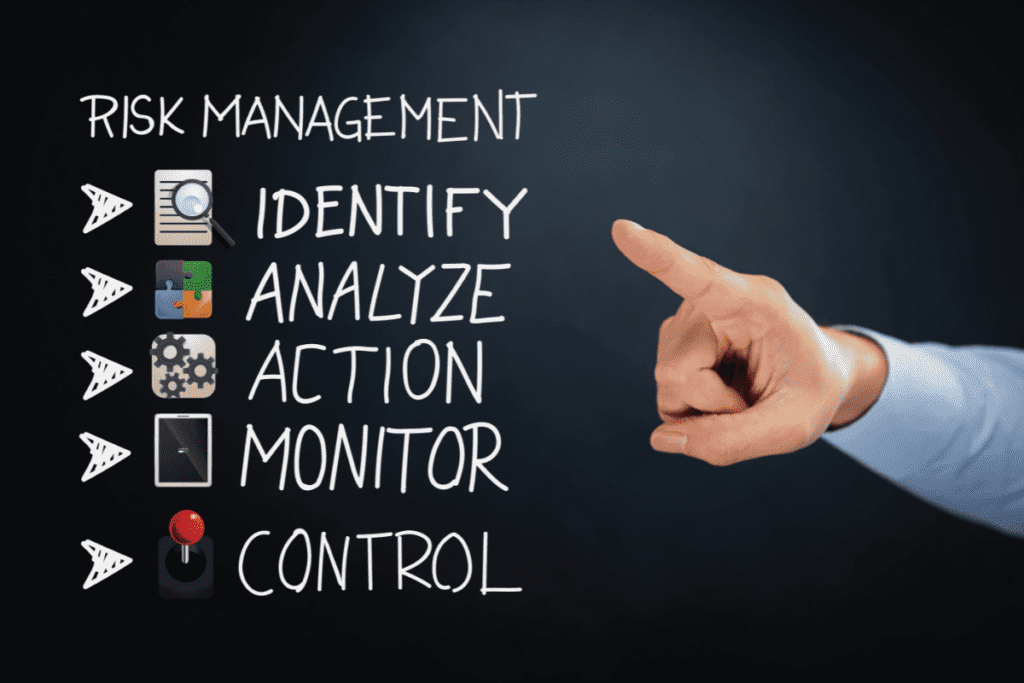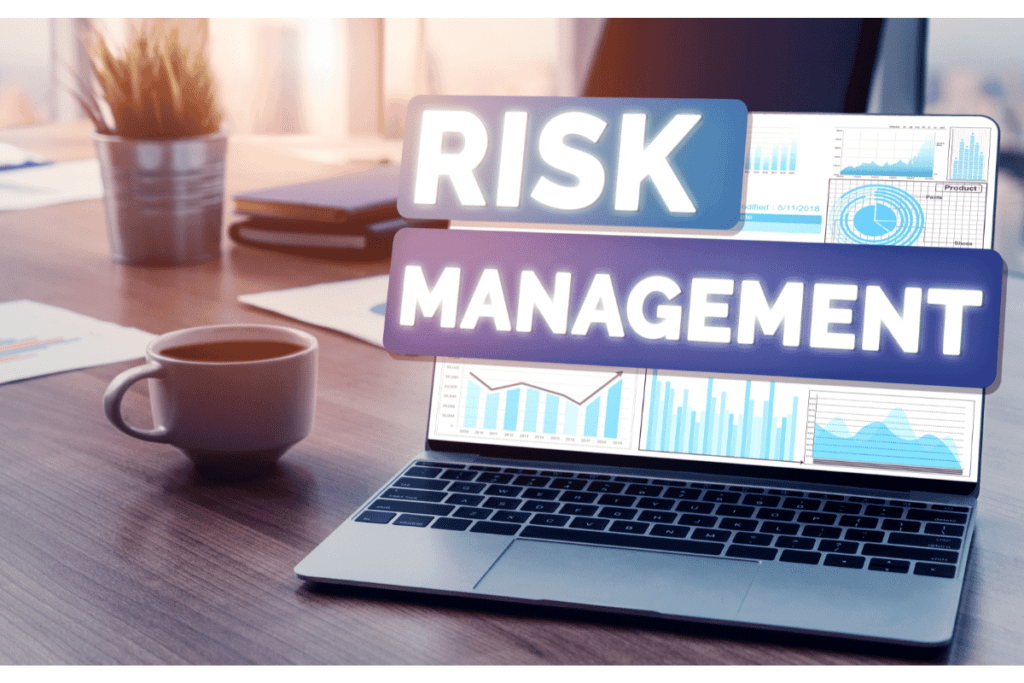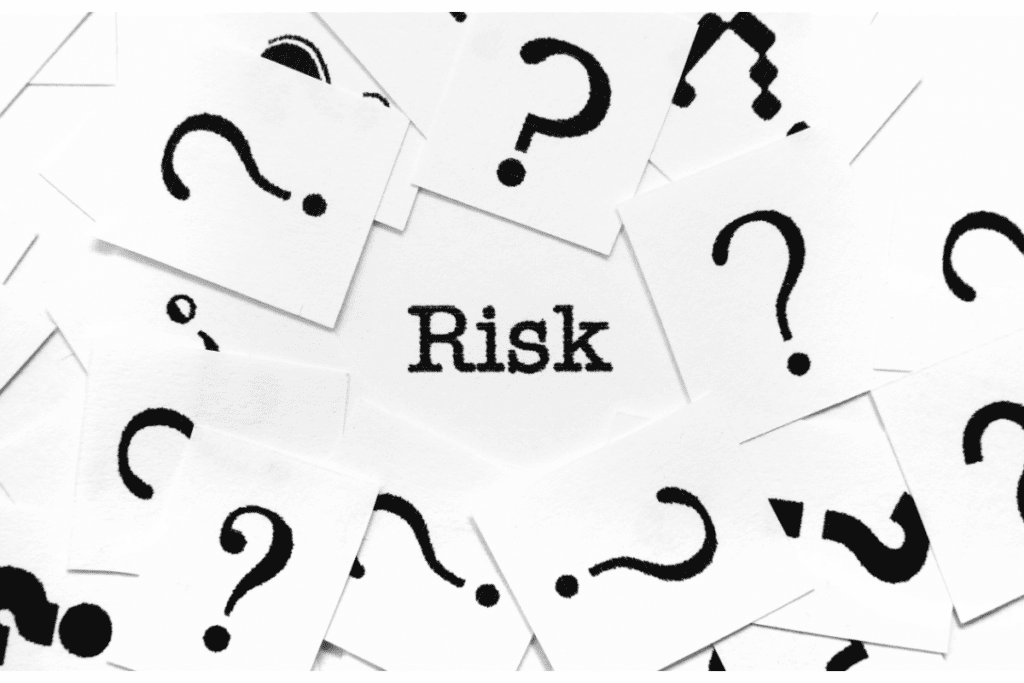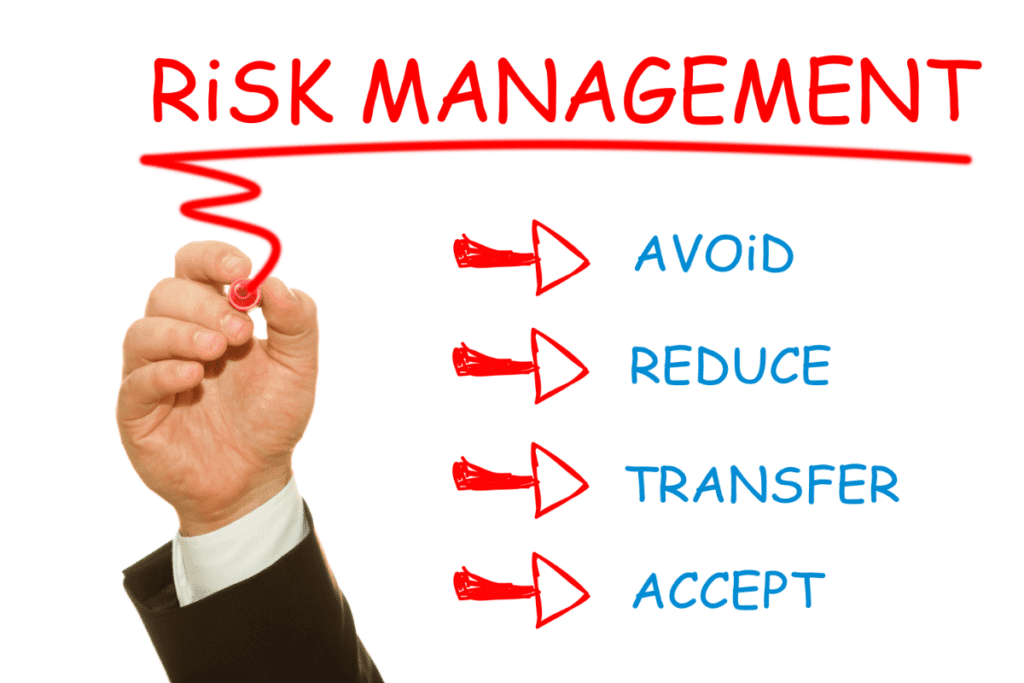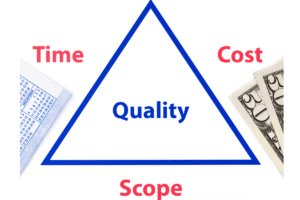A Comprehensive Guide to Project Risk Management in Project Management
Introduction
If you’ve ever had an IT project go off the rails, you know how critical risk management is. Surprisingly, a staggering 70% of IT projects fail due to inadequate project risk management strategies. This comprehensive guide provides practical steps and handy tips to mitigate risks and steer your IT project towards success effortlessly.
Are you ready to conquer those unforeseen challenges? Let’s dive in!
Key Takeaways
- Risk management is crucial for the success of IT projects, as inadequate risk management strategies contribute to a staggering 70% failure rate.
- Project risk management involves identifying, analyzing, and responding to potential risks that could impact project objectives. It includes creating contingency plans and assigning tasks to prevent delays or derailment.
- Risks in IT projects can be categorized into scope, schedule, cost, quality, resource, communication, technology, vendor, security, strategy, external factors,and compliance risks.
- Techniques for identifying risks include brainstorming sessions with stakeholders,sWOT analysis,interviews with subject matter experts and team members,reviewing past projects or industry research,and utilizing predefined checklists or templates.
- Analyzing identified risks involves evaluating each risk’s impact and likelihood using a score-based approach. Deciding on a risk management strategy involves allocating resources effectively and developing response plans based on the severity of each risk.
Understanding Project Risk Management
Project risk management involves minimizing potential issues that can disrupt the timeline or completion of a project.
Definition of Project Risk Management
Project risk management is a critical aspect of successful project execution, especially in the dynamic world of IT. It refers to the systematic process of identifying, analyzing, and responding to any potential risks that could adversely impact a project’s objectives.
This active approach includes creating contingency plans for unseen events or known risks and assigning specific tasks to team members for monitoring these threats. By preparing for uncertainties like scope creep or budget control issues, it equips teams with strategies to prevent delays or derailment, keeping your IT projects on time and within budget.
Importance of Risk Management in IT Projects
Project Risk Management plays a pivotal role in IT projects, acting as a safety net that ensures the successful delivery of tasks and objectives. By considering potential issues threatening the project timeline or completion, such as scope creep or budget control issues – risk management allows for strategies to be developed ahead of time to mitigate these eventualities.
In an industry where advancements are rapid and changes are frequent, risks like technology risk and resistance to change become more prevalent. Identifying possible risks through brainstorming sessions and stakeholder interviews provides insights that can be used for effective risk analysis.
As part of this process, the impact and likelihood of each identified risk are assessed using a score-based approach, creating clear visibility on which aspects require most attention. This proactive approach not only saves time but can also significantly decrease contingency costs by preventing unnecessary derailments in your IT project’s progression.
Risk Categories in IT Projects
In the realm of IT projects, risks are diverse and can be grouped into several categories. Each category represents a different aspect of project execution where things can go awry if not appropriately managed:
- Scope Risks: These are uncertainties related to the project’s scope, including risks of scope creep or incomplete requirements.
- Schedule Risks: Such risks involve the potential for delays in the project timeline that could push back delivery dates.
- Cost Risks: They entail any financial uncertainties that could cause budget control issues, such as inaccurate cost estimates or unplanned expenses.
- Quality Risks: This covers problems related to software bugs, poor design practices, inadequate testing procedures, etc., which may compromise product quality.
- Resource Risks: These relate to potential difficulties in securing necessary human resources or materials needed for successful project completion.
- Communication Risks: The failure in communication between stakeholders that may lead to misunderstandings or lack of alignment on project objectives is included here.
- Technology Risks: These are uncertainties regarding technology selection and implementation, which could potentially disrupt the project execution phase due to technical shortcomings or technological obsolescence.
- Vendor Risks: It poses challenges related to outsourcing parts of your IT project and managing contract risk with third-party service providers.
- Security Risks: To ensure data privacy and system integrity during the project management process is crucial; threats like cyberattacks comprise this category.
- Strategy Risks: They involve unanticipated changes in business strategy that can impact project goals or viability.
- External Risks: These consist of unforeseen external disruptions such as legal changes, natural disasters, pandemics, or industry shifts impacting the IT project execution.
- Compliance Risks: Interface with regulatory compliance requirements and associated impacts due to non-compliance form this category.
Identifying Risks in IT Projects
To identify risks in IT projects, project managers use various techniques. A few of these techniques are brainstorming sessions, individual interviews with stakeholders, and evaluating similar past projects.
What is Project Risk Identification?
Project risk identification is the process of identifying potential risks that could impact the successful completion of a project. It involves systematically analyzing various aspects of the project, such as scope, budget, schedule, technology, and stakeholders, to identify any potential threats or uncertainties.
By proactively identifying risks early on in the project lifecycle, project teams can develop strategies to mitigate or address these risks before they become major issues. Risk identification techniques include brainstorming sessions with relevant stakeholders, conducting interviews with subject matter experts, and analyzing historical data from similar projects.
Techniques to Identify Risks
To effectively identify risks in IT projects, project managers and teams can utilize various techniques. These techniques help to identify potential issues that may arise during the project lifecycle. Here are some techniques commonly used to identify risks:

Analyzing the Identified Risks
In analyzing the identified risks, evaluate each risk by assessing its potential impact and likelihood of occurrence using a score-based approach.
Evaluating the Risk
Evaluating the risk is a crucial step in project risk management for IT projects. It involves assessing the impact and likelihood of identified risks to determine their significance and prioritize them accordingly.
By using a score-based approach, such as a Risk Heat Map, you can assign numerical values to each risk based on factors like potential consequences and probability of occurrence.
This helps you understand which risks are most critical to address and allocate resources effectively. Evaluating the risk allows you to make informed decisions about how best to manage each identified risk, ensuring that your project stays on track and minimizes any potential disruptions or setbacks.
Deciding on Risk Management Strategy
Deciding on a risk management strategy is a critical step in ensuring the successful completion of an IT project. Once risks have been identified and analyzed, it’s important to determine how each risk will be managed or mitigated.
This involves carefully evaluating the potential impact and likelihood of each risk and then developing an appropriate response plan. The goal is to minimize negative consequences while maximizing opportunities for success.
By assigning owners for each risk, accountability can be established, ensuring that someone takes responsibility for monitoring and addressing the risk throughout the project lifecycle.
With a well-defined risk management strategy in place, IT projects can proceed with confidence, knowing that potential challenges are being proactively addressed.
It’s essential to remember that not all risks require the same level of attention or response. Some risks may have minimal impact or likelihood, making them easier to accept or monitor closely without taking immediate action.
A Step-By-Step Guide to IT Project Risk Management
In this section, we will provide a comprehensive step-by-step guide to managing risks in IT projects.
Step 1: Creating a Risk Register
To effectively manage and mitigate risks in IT projects, the first step is creating a risk register. A risk register serves as an itemized list of potential risks that can potentially derail a project.
It helps project teams identify and prioritize possible threats early on, allowing them to develop proactive strategies to address these risks before they materialize. Typically created in a spreadsheet format, the register includes key details such as the nature of each risk, its potential impact on the project objectives, likelihood of occurrence, and proposed response strategies.
By diligently documenting and updating this comprehensive inventory of risks throughout the project lifecycle, teams can significantly enhance their ability to prevent unexpected issues or delays while maintaining control over budgets and resources.
Step 2: Identifying Relevant Risks
Identifying relevant risks is a crucial step in effective IT project risk management. It involves thoroughly analyzing the project’s scope, goals, and potential challenges to identify any factors that could lead to negative outcomes or disruptions.
This process helps project teams prioritize their efforts and allocate resources accordingly, allowing them to proactively address potential issues before they escalate. By involving cross-functional teams with varying experience levels early on, organizations can gather diverse perspectives and insights, ensuring a comprehensive identification of risks that might otherwise be overlooked.
Ultimately, identifying relevant risks allows for better planning and decision-making throughout the entire project lifecycle.
Step 3: Performing a Risk Analysis
Performing a risk analysis is a crucial step in effectively managing the risks associated with IT projects. During this step, the project team assesses the impact and likelihood of each identified risk.
By evaluating these factors, they can determine which risks require immediate attention and prioritize their efforts accordingly. The risk value, calculated by multiplying the probability of risk occurrence by its potential cost, helps guide this prioritization process.
This analysis allows project teams to proactively identify and address potential obstacles or challenges that could arise during project execution. By considering various scenarios and their potential impacts on the project’s timeline, resources, and budget, teams can develop strategies to mitigate or minimize these risks.
Step 4: Developing a Response Plan
Developing a response plan is a crucial step in IT project risk management. Once the risks have been identified and analyzed, it’s time to determine strategies to mitigate or address each of them.
The response plan outlines specific actions that need to be taken if a risk event occurs during the project execution phase. By having a well-defined plan in place, you can minimize the potential impact of risks on your project’s objectives and ensure smooth progress.
Assigning owners for each risk is an important aspect of developing the response plan. This helps in establishing accountability and responsibility for monitoring and managing the risks effectively.
Step 5: Assigning Owners for Each Risk
Assigning owners for each risk is a crucial step in the process of IT project risk management. By assigning specific individuals to be responsible for managing and mitigating each identified risk, there is a clear line of accountability and authority.
These owners play a vital role in proactively monitoring and controlling the risks, coordinating with stakeholders and team members, and implementing effective response plans. This not only ensures that risks are addressed promptly but also streamlines the overall risk management process.
Furthermore, assigning owners allows for better evaluation of the potential impact of each risk on the project, enabling proactive decision-making to mitigate any potential negative consequences.
Using Project Management Software for Project Risk Management
Project management software can greatly enhance the efficiency and effectiveness of project risk management, providing benefits such as improved collaboration, real-time tracking, and automated reporting.
Look for software that allows you to easily create and manage a risk register, track and analyze identified risks, develop response plans, and assign owners for each risk.
It should also provide features like notifications and reminders to ensure timely monitoring of risks. Additionally, consider software that integrates seamlessly with your existing project management tools and methodologies.
Benefits of Using Management Software
Management software can provide numerous benefits for project risk management in IT projects. These benefits include:
Streamlined Communication:
Management software allows for seamless communication between team members, stakeholders, and project managers. This ensures everyone is kept up-to-date on potential risks and their mitigation strategies.
Centralized Information:
With management software, all risk-related information is stored in one centralized location. This makes it easy to access and review the risk log, risk register, and other important documents.
Real-Time Monitoring:
Management software allows for real-time monitoring of project risks. This means that any changes or updates to the risk landscape can be identified immediately, allowing for timely response and mitigation efforts.
Improved Collaboration:
Collaborative features within management software enable team members to work together more effectively on managing project risks. This includes assigning tasks related to risk mitigation, tracking progress, and ensuring accountability.
Enhanced Risk Analysis:
Management software often includes advanced analytical tools that can assist with risk analysis. These tools can help identify patterns or trends in past projects, allowing for more accurate assessment of current risks.
Increased Efficiency:
By automating certain aspects of risk management, such as generating reports or sending notifications, management software can significantly improve efficiency in handling risks. This frees up time for project teams to focus on other critical tasks.
Customizable Dashboards:
Many management software solutions offer customizable dashboards that allow users to tailor the display of information according to their specific needs and preferences. This makes it easier to monitor and track risks in a way that is most effective for each individual user.
Scalability and Flexibility:
Management software can easily accommodate projects of different sizes and complexities. Whether it’s a small-scale IT project or a large enterprise-level initiative, the software can be scaled accordingly without compromising its functionality.
Documentation and Audit Trail:
Management software provides a comprehensive audit trail by logging all activities related to risk management. This ensures that historical data is preserved and can be used for future reference or compliance purposes.
Cost Savings:
Implementing management software can lead to cost savings in the long run. By identifying and mitigating risks early on, projects are less likely to experience costly delays or budget overruns.
Choosing the Right Management Software
Choosing the right management software is a critical step in effectively managing project risks for IT projects. With numerous options available, it’s important to select a software solution that aligns with your organization’s specific needs and requirements.
Mitigating Risks in IT Projects
In order to mitigate risks in IT projects, it is crucial to integrate risk management into Agile projects and consider the role of risk attitudes within the project.
How to Integrate Risk Management into Agile Projects
Integrating risk management into agile projects is crucial for ensuring project success and minimizing potential disruptions. In an agile environment, where change is constant and iterations are rapid, it’s important to have a flexible approach to risk management.
One way to do this is by incorporating risk assessments and mitigation strategies into each sprint or iteration. By regularly analyzing potential risks and taking proactive measures, teams can identify and address issues early on, preventing them from escalating into larger problems.
Additionally, fostering open communication within the team enables prompt identification of new risks that arise during the project lifecycle. This collaborative approach ensures that risk management becomes an intrinsic part of the agile process.
Another key aspect of integrating risk management in agile projects is continuously reassessing priorities based on changing circumstances. As the project progresses, reevaluating risks becomes essential to adapt the mitigation strategies accordingly.
Agile methodologies provide opportunities for frequent retrospectives where teams can assess what worked well and what could be improved in terms of managing risks. By prioritizing these discussions alongside other project activities, teams can better anticipate challenges and take timely actions to mitigate them effectively.
The Role of Risk Attitudes in Your IT Project
The success of an IT project heavily depends on the attitudes towards risk within the project team and stakeholders. Different individuals may have varying risk tolerances, which can impact decision-making and how risks are addressed throughout the project lifecycle.
Understanding these risk attitudes is essential in effectively managing risks.
Having a diverse team with different risk attitudes can bring valuable perspectives to risk management discussions. Some team members may be more risk-averse, preferring conservative approaches that prioritize stability and minimize potential negative impacts.
On the other hand, some individuals may be more open to taking calculated risks in order to seize opportunities for innovation and growth.
By recognizing and accommodating various risk attitudes, project leaders can foster a collaborative environment where all stakeholders feel comfortable expressing their concerns or ideas related to risks.
This allows for more comprehensive risk identification and evaluation, leading to informed decisions about appropriate risk responses.
Additionally, understanding individual risk attitudes enables better communication and alignment among team members. It helps establish realistic expectations about potential risks and outcomes upfront, reducing misunderstandings or conflicts as the project progresses.
Quantifying Qualitative Risk: An Overview
Quantifying qualitative risk is a crucial step in project risk management. While some risks can be easily measured, such as financial or technical risks, many others are more subjective and require a qualitative assessment.
This involves evaluating the potential impact of these risks on the project objectives and determining their likelihood of occurrence. By assigning scores or ratings to each risk based on these factors, project managers can prioritize them and allocate appropriate resources for mitigation.
Quantifying qualitative risk allows project teams to make informed decisions by providing a quantitative measure to subjective risks. It helps in identifying high-priority risks that may require immediate attention and resource allocation.
Additionally, it enables better communication with stakeholders by presenting tangible data that supports decision-making processes.
To quantify qualitative risk effectively, project teams typically use techniques like probability-impact matrix, risk analysis workshops, or expert judgment. These methods help in assigning numerical values to various dimensions of each identified risk so that they can be compared objectively against other risks.
Managing the Risks You Didn’t Know You Were Taking
Many IT projects are plagued by unexpected risks that arise from factors the project team didn’t even consider. These hidden risks can have a significant impact on project timelines and budgets if left unaddressed.
To effectively manage these unforeseen risks, it is crucial to conduct a comprehensive risk assessment at the beginning of the project and continuously monitor for potential new risks throughout its duration.
By actively seeking out and addressing these unknown risks, project teams can ensure smooth progress and minimize disruptions as they arise.
One approach to managing these hidden risks is through regular risk review and monitoring. This involves consistently evaluating the potential for new risks to emerge and promptly developing appropriate response plans when needed.
Additionally, incorporating lessons learned from previous IT projects into risk management practices can help identify common pitfalls that may not be immediately apparent but could still threaten success in similar endeavors.
FAQs
1. What is project risk management and why is it important for IT projects?
Project risk management refers to the process of identifying, assessing, and prioritizing potential risks that may impact the success of an IT project. It is crucial for IT projects because technology initiatives often involve complex systems, dependencies, and uncertainties that can lead to unforeseen challenges or failures. Effective risk management helps mitigate these risks and enhances the chances of achieving project objectives.
2. How do you identify potential risks in an IT project?
Identifying potential risks in an IT project involves conducting a thorough analysis of various factors such as project scope, requirements, technology infrastructure, stakeholders’ expectations, regulatory compliance, external dependencies, and market conditions. This can be done through brainstorming sessions with key team members or stakeholders, reviewing historical data from similar projects or industry benchmarks, and leveraging specialized tools or frameworks designed for risk identification.
3. What are some common techniques used for mitigating risks in IT projects?
Below are some common techniques used for mitigating risks.
Risk:
– Avoidance: Taking proactive measures to eliminate or avoid identified risks.
– Transfer: Shifting the responsibility or impact of a risk to another party through contracts or insurance.
– Mitigation: Implementing actions or controls to reduce the likelihood or impact of identified risks.
– Acceptance: Acknowledging that certain risks cannot be fully eliminated but accepting them on a conscious basis while planning contingencies.
4. How can effective communication contribute to successful project risk management in IT projects?
Effective communication plays a critical role in successful project risk management by ensuring that all relevant stakeholders are aware of potential risks, their implications on the project’s objectives and timelines,
and the planned mitigation strategies. Regular communication channels help maintain transparency, enable early awareness of emerging issues,
facilitate collaboration among team members, and allow for timely adjustments in risk management strategies as the project progresses.
Conclusion
In conclusion, effective project risk management is crucial for the success of IT projects. By identifying and analyzing risks, developing response plans, and assigning owners, organizations can mitigate potential issues that may arise during project execution.
Utilizing project management software and integrating risk management into agile methodologies further enhances risk mitigation efforts. With a comprehensive approach to project risk management, IT projects can be completed on time, within budget, and with minimal disruptions or setbacks.
If you liked this article, remember to subscribe to MiamiCloud.com. Connect. Learn. Innovate.



